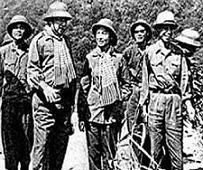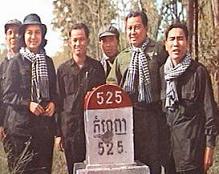|
Ainsi, cette présence communiste vietnamienne favorisa le développement du mouvement Khmer Rouge. Avec la multiplication des incidents armés et les révoltes comme celle de Samlaut, le Gouvernement Royal finit par prendre peur.
>> voir l'interview de Norodom Sihanouk par F.Chalais. Oct-1967 Institut National de l’Audiovisuel, France www.ina.fr
La Chine est dénoncée mais le trafic avec les Vietcongs n'en demeure pas moins. Leurs sanctuaires deviennent de véritables bases. En cascade, les américains intensifient les bombardements sur le Cambodge. Nous, militaires, commencons à perdre le contrôle de notre territoire.
La situation générale se déteriore.
le Chef de l'Etat dénonce maintenant la présence des communistes Vietnamiens, dans ses discours mais aussi à la ...
>> conférence de presse du 28 mars 1969 où il présenta une carte détaillée des implantations vietnamiennes.
>> Le numéro de Juin 1969 du mensuel 'Le Sangkum' (voir extraits), organe de presse de l’Etat, publia l'entretien du 24 Mai 1969 du ministre de la défense Lon Nol avec les ambassadeurs du Nord Vietnam et du Front National de Libération du Vietnam du Sud. Sont entre autre évoqués, la présence Vietcong dans la province de Pursat... Dans le pays, rien qu'en 1969, près de 400 soldats Vietcongs sont arrêtés mais ils sont relachés sur ordre du chef de l'état. (Des officiers de l'AVRK avaient assisté à une de ces arrestations)


Le Prince Sihanouk avec les Vietcongs et les KR. (à sa droite Khieu Samphan)
Nous sommes pris dans le brasier. Nous, militaires et aviateurs, nous sommes au service de notre Nation. Qu'elle soit Monarchique ou qu'elle soit Républicaine.
Plus tard, le Prince Sihanouk déclara qu’il fera chasser les Phnom-Penhois pour les punir (voir son entretien avec A.Peyrefitte, Paris-Match N°1353). Une telle idée ne peut que convenir aux Khmers Rouges. En Avril 1975, toute la population de la ville fut brutalement déportée.
| Cher Ami et
Excellence, Je vous remercie très sincèrement pour votre lettre et votre offre de me transporter vers la liberté. Je ne peux pas hélas, lâchement quitter de la sorte. Je n’ai jamais pensé un seul instant, que vous et en particulier votre grand pays, ressentiriez ce sentiment d’abandonner un peuple qui a choisi la liberté. Vous nous avez refusé votre protection et nous ne pouvons rien faire à cela. Vous nous quittez, et je souhaite que vous et votre pays trouverez le Bonheur sous le ciel. Notez bien ceci, si je dois mourir ici, sur le champ, dans mon pays que j’aime, c’est dommage mais nous sommes tous nés et tous, nous devons mourir un jour. J’ai seulement commis la faute de croire en vous, les Américains. Acceptez, son Excellence, mon Cher Ami, mes sentiments fidèles et amicaux. Sirik Matak |

